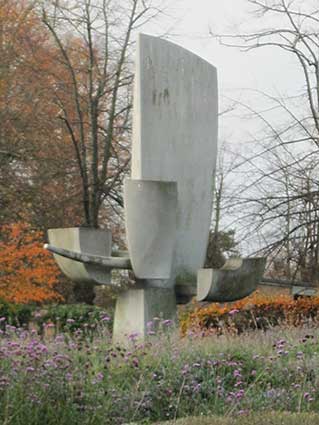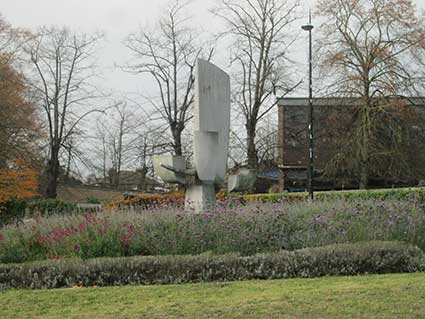Ship by Bernard
Reynolds
 2018 images
2018 images
Above: the view in autumn 2018 from outside the former law
courts with, right, part of St Matthew's Primary School in the
background.
 2021 image
2021 image
Constructed by this local sculptor in 1971, the following year Ship was originally sited at the
foot of Civic Centre (now demolished) where it originally stood in a
pool of water with six
jets splashing the base. Most people recall it sitting in a dry pool.
In 1996 this sculpture was moved from its neglected position to the
centre of the Civic Drive/Handford Road
roundabout surrounded by
planting. In this way, the sculpture gained a massive new audience of
thousands of travellers a week.
 pre-1996
pre-1996
The above image comes from the Ipswich Society Image Archive (see Links).
Ship is described on the
Public Sculpture of Norfolk and
Suffolk website (see Links)
as: fibreglass sculpture in battleship grey suggesting the form of a
ship – set at the top of a roundabout surrounded by plants – oriented
downhill towards the docks and Felixstowe. While mainly abstract in
conception and essentially a spatial exercise in sculptural form
designed to be seen from multiple angles, Ship is also an arrangement of sail
and hull motifs suggesting 'ships and shipping through the ages - a
tribute to Ipswich as a port'.
Bernard Reynolds was born on 2 June 1915 in Norwich and lived for
almost fifty years in Ipswich. In 1932, at the age of 17, he studied at
Norwich School of Art. In the final year of his studies, he expressed
his inclination towards sculpture. In 1937, he moved to London to
continue his studies at the Westminster School of Art. One year later,
Reynolds got a post as a naval instruments engineer in Norwich and this
endured throughout the Second World War. This wartime experience as an
engineer seems to have strengthened rather than repressed his artistic
practice. In fact, craftsmanship has influenced his observations
vis-a-vis nature and mankind. He constantly expanded the knowledge of
materials and techniques in his sculpture studio. As he noted, "I was
one who was always interested in things, in specimens, and so that
brought me round strongly on the side of sculpture ... the forms of
solid nature rather than views of nature."
He became an inspirational teacher over thirty-four years of art school
teaching. In 1948 he gained the post at Ipswich School of Art, for
which his application was very exceptional in showing evidence of his
talented techniques. Thanks to him, the sculpture course in East Anglia
stood out amongst other schools of art by the late fifties. As a man
who 'lived by and for his art', Bernard Reynold's deep dedication to
his calling was never in question. Apart from his involvement in
exhibitions and teaching, Reynolds was commissioned to create
sculptures for several buildings in Ipswich. He made cement reliefs on
the Castle Hill and Sprites Lane schools,
the pair of 22 foot Pylons which flanked the
entrance to Suffolk
College (now rebuilt as Suffolk New College, but the pylons survive in situ), a 24 foot stained-glass
window in St. Matthew's School and the 14 foot-high Ship Fountain Sculpture at the
Civic Centre show on this page. Because of it, he was awarded the Sir
Otto Beit Medal for 1972. It was 'the best piece of sculpture to come
to the notice of the Royal Society of British Sculptors as being set up
anywhere in the British Commonwealth, excluding London, during that
year'.
[A reference to a stone relief on the Eastern Counties
Farmers Head Office has been found. This attribution
occurs on the web, but isn't backed up any the
entry on the Public
Sculpture of Norfolk and Suffolk
website.]
Bernard Reynolds died in 1997.
See also Triple Mycomorph
(Fungus Form) sculpture on our Christchurch
Mansion & Park page under 'The Wolsey Art Gallery/Wolsey Garden'.
Home
Please email any comments and
contributions by clicking here.
Search Ipswich
Historic Lettering
©2004 Copyright
throughout the Ipswich
Historic Lettering site: Borin Van Loon
No reproduction of text
or images without express
written permission
 2018 images
2018 images
 2021 image
2021 image pre-1996
pre-1996